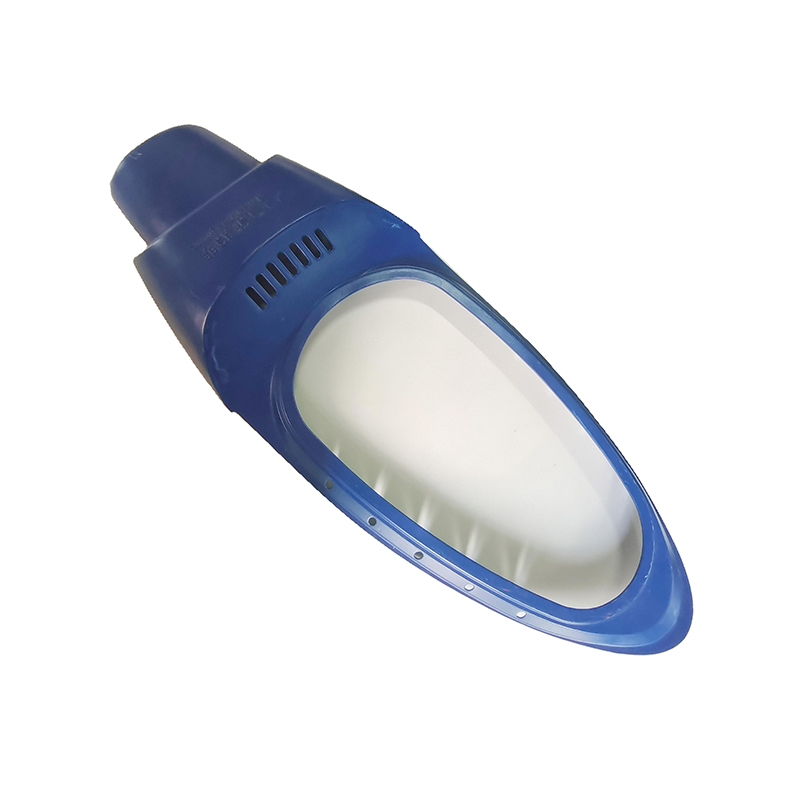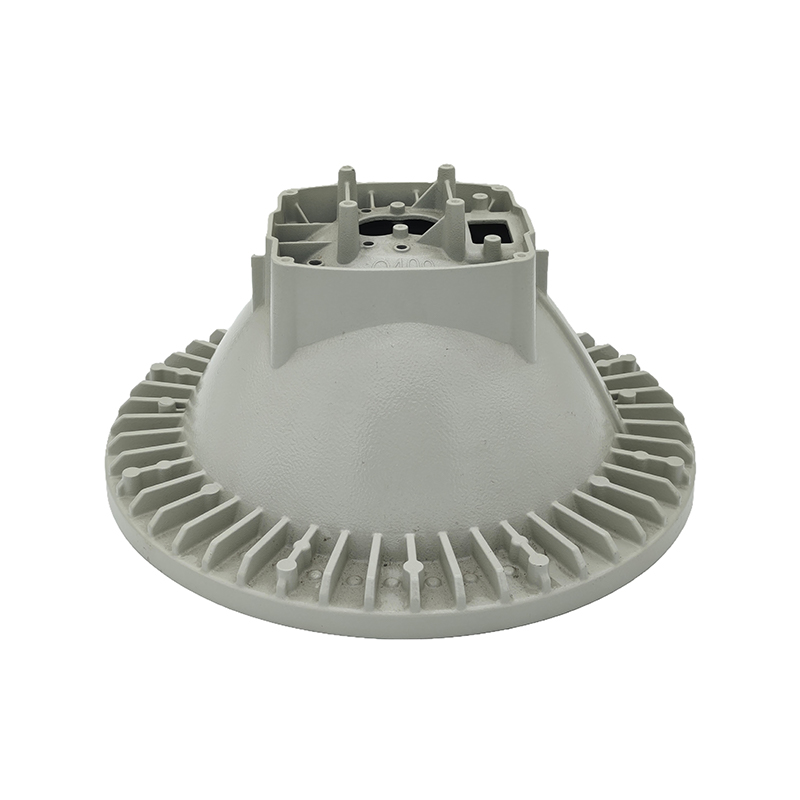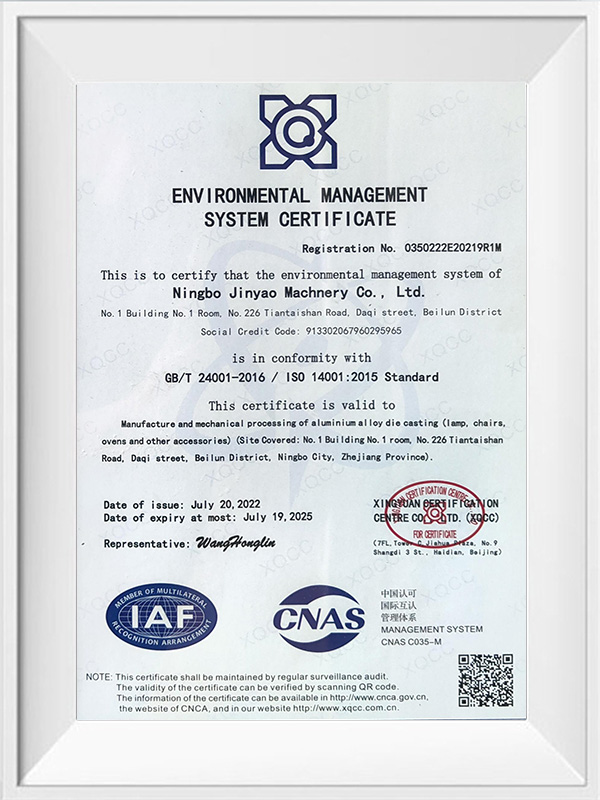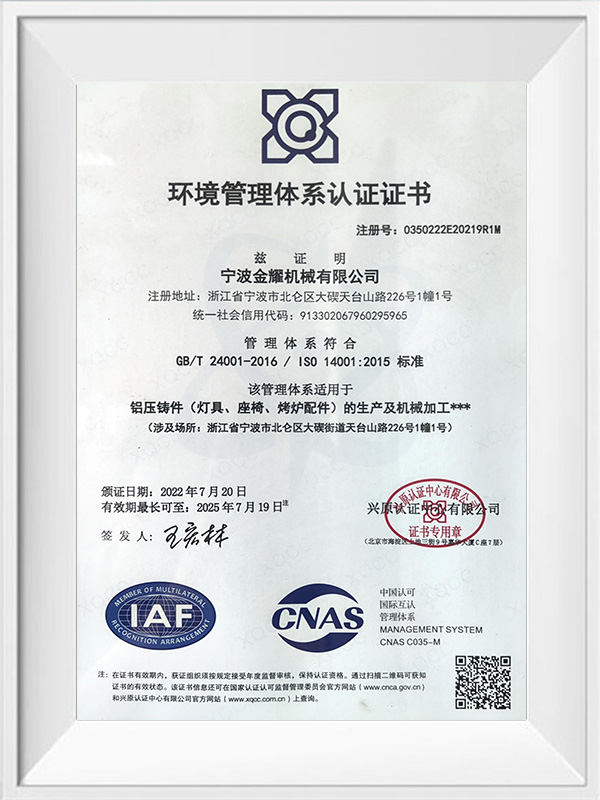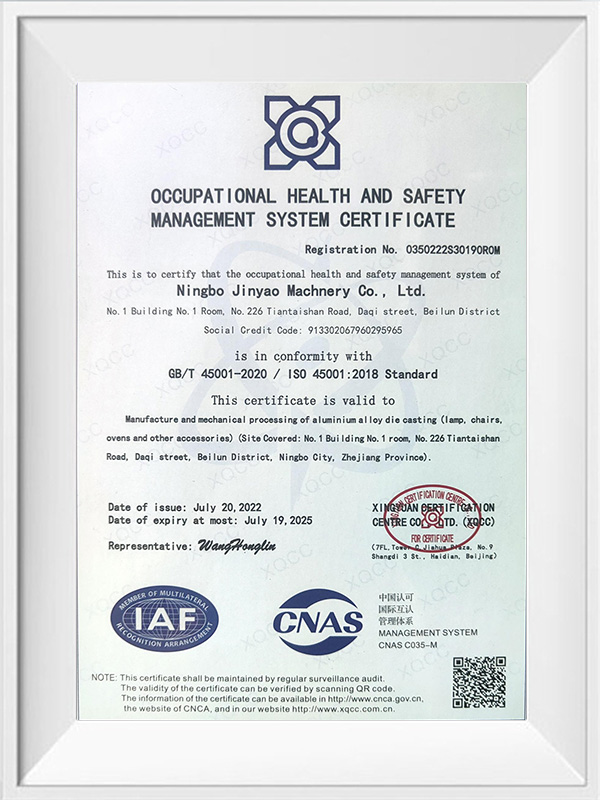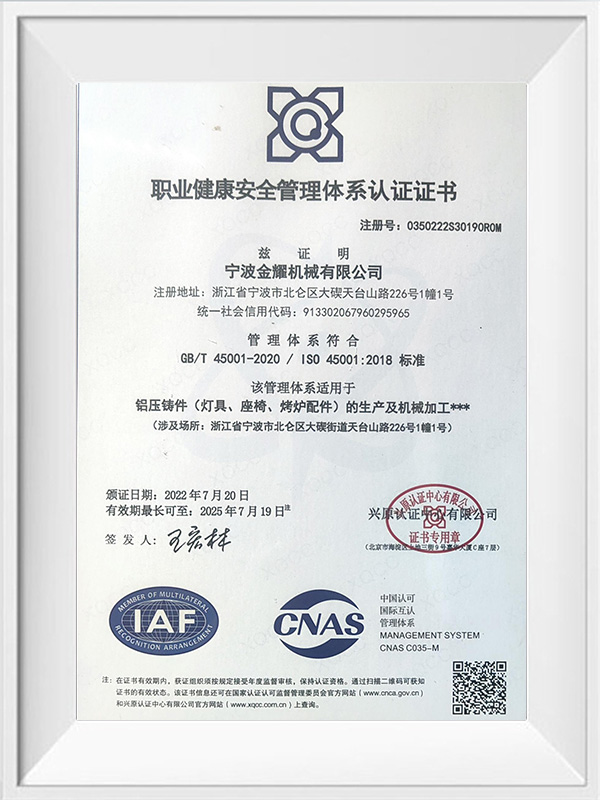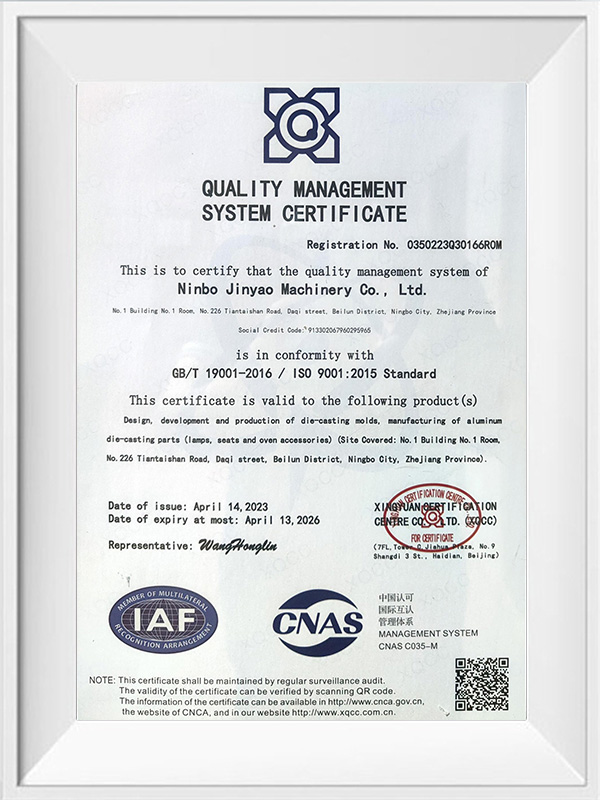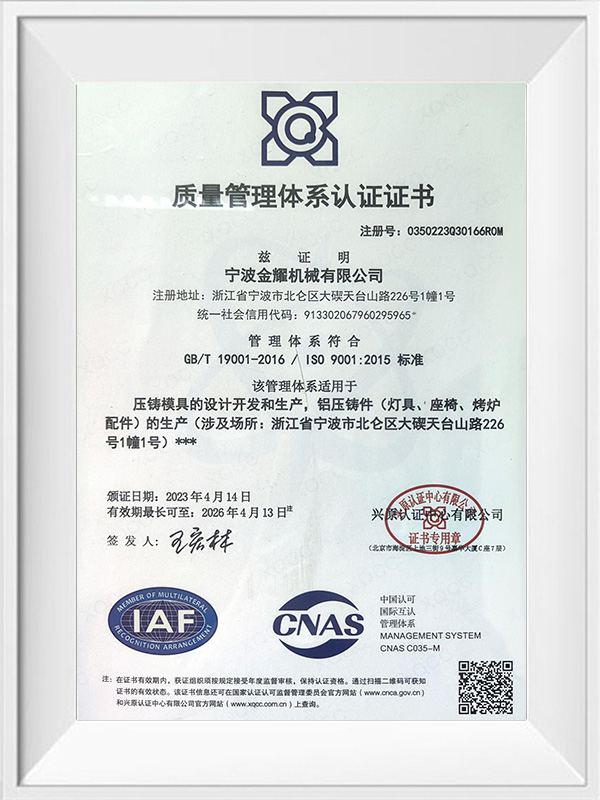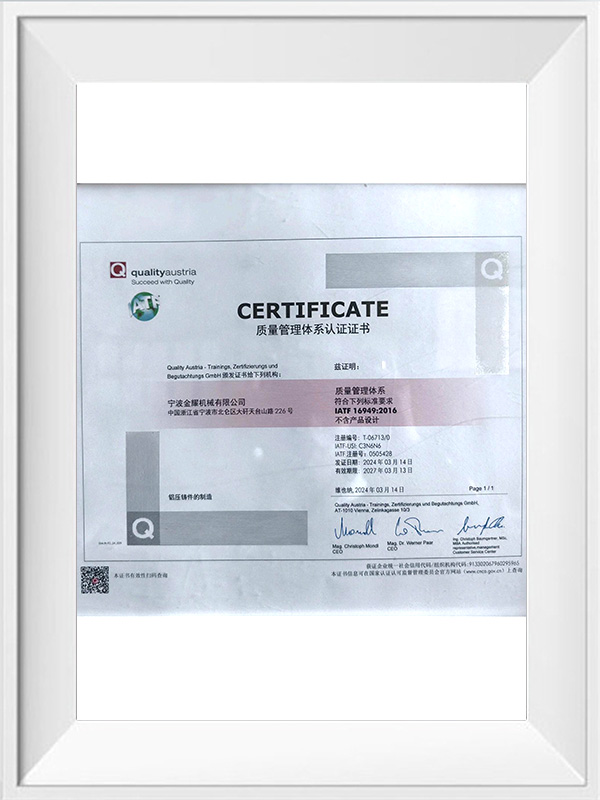Ningbo Jinyao Machinery Co., Ltd. is a China Lighting Die Castings Manufacturers and Lighting Die Castings Factory. And is an enterprise integrating industry and trade, dedicated to the production of precision castings of aluminum alloy materials and the design and manufacture of high-pressure die-casting molds. Adopting advanced vacuuming, pin extrusion, and high-pressure spot cooling processes, it is a large-scale professional production base for diversified casting in China. It integrates a precision casting factory and a mechanical processing plant, and can produce precision castings and various types of castings annually. More than 10,000 tons, mainly exported to Japan, Sweden and other countries. Among the customers we cooperate with are many OEM customers of trains, cars, forklifts, outboards, communication equipment, lamps, furniture parts and engineering machinery, including the world's top 500 companies. , has become an important supplier of their precision castings in China.
Lighting Die Castings Manufacturers
- Traditional automobile die castings
- New energy automobile die castings
- Communication housing die castings
- Electric scooter die castings
- Bicycle power motor die castings
- Motorcycle accessories die castings
- Motor housing die castings
- Engineering machinery die castings
- Lighting die castings
- Outboard motor die castings
- Furniture accessories die castings
- Grill accessories die casting
- Photovoltaic inverter die castings
Lighting die castings play a crucial role in the lighting industry, especially in the production of LED lighting fixtures. Their primary function is to provide strong structural support and heat dissipation, ensuring the stability of the light source and prolonging the product’s lifespan. These die castings are typically made from aluminum alloys, formed through high-pressure die casting using precision molds. This process ensures both the high accuracy and formation of complex geometries while improving production efficiency and part consistency.
Aluminum alloy offers advantages such as lightweight, high strength, ease of machining, and casting properties. It has a smooth surface finish, stable casting quality, and is recyclable, making it suitable for manufacturing heat sinks, lamp bodies, and face rings in lighting fixtures. High-performance, high-precision, and high-toughness aluminum die castings can be used in larger or specialized lighting systems with more stringent requirements.
The key highlights of lighting die castings include their thermal conductivity and corrosion resistance, allowing them to dissipate heat efficiently in high-temperature working environments, preventing overheating of the light source, and ensuring long-lasting illumination. Additionally, die castings exhibit dimensional stability and high strength, achieving lightweight designs while maintaining strong structural integrity. With optimized mold design and process control, lighting die castings meet strict aesthetic and performance standards, making them indispensable components in modern lighting solutions.
Lighting die castings have a wide range of applications, from everyday household lights to commercial and industrial lighting. As lighting technology continues to evolve and innovate, these die castings are continually being improved and optimized to meet the increasing demand for higher performance and quality in lighting products.
-
What is Anodized Aluminum Die Casting and How Does It Work?View More
Anodized aluminum die casting is a highly efficient manufacturing process that combines two distinct techniques—die casting and anodizing—into one to create parts that are both highly durable and visually appealing. This process is particularly beneficial for industries that require components with ...

-
How Does Die Casting Surface Treatment Improve Product Durability?View More
Die casting is one of the most widely used metal manufacturing processes, providing high precision, complex shapes, and efficiency. However, raw die-cast components often face challenges such as corrosion, wear, surface defects, and reduced longevity. Implementing proper die casting surface treatme...

-
What Are the Common Defects Found in Die Casting Molds and How Can They Be Prevented?View More
Die casting is a popular and efficient manufacturing process for producing high-precision metal parts. It is widely used across many industries such as automotive, aerospace, and electronics. Like any manufacturing process, die casting is prone to defects, which can negatively affect part quality, p...

How does the durability and strength of lighting die castings affect the service life of lamps?
The relationship between the durability and strength of lighting die castings and the service life of lamps
In the lighting industry, die castings are key components of lamps, and their durability and strength have a direct impact on the service life of lamps. Lighting die castings are mainly used to support and protect other components of lamps, and also play an important role in heat dissipation and structural stability. Ningbo Jinyao Machinery Co., Ltd., as a leading domestic manufacturer of precision castings made of aluminum alloy materials, has long been committed to the design and manufacture of high-pressure die-casting molds and has produced a large number of high-quality lighting die castings. Through the company's precise manufacturing process and years of industry experience, Ningbo Jinyao Machinery Co., Ltd.'s products have been widely used in various types of lamps, providing a solid guarantee for improving the durability and strength of lamps.
How the durability of lighting die castings affects the stability of lamps
The durability of lighting die castings determines the stability of lamps in various environments. Especially in outdoor or harsh environments, lamps need to be exposed to high temperature, humidity, or even corrosive gases for a long time. Die castings with poor durability may crack or deform, resulting in reduced performance of lamps or even failures. Ningbo Jinyao Machinery Co., Ltd. adopts advanced production processes such as vacuum casting and high-pressure spot cooling processes, which can significantly improve the durability of aluminum alloy materials, ensure that lamps can still maintain good working conditions in complex environments, and extend the service life of lamps.
How does the strength of lighting die-castings affect the structural stability of lamps
Strength is another important indicator of lighting die-castings. It reflects the bearing capacity of die-castings when subjected to external pressure, impact or load. Lamps may be subjected to external impact or extrusion during installation and transportation. If the strength of lighting die-castings is insufficient, it may cause deformation or cracking, thereby affecting the structural stability of lamps. Especially in large-scale lighting equipment such as industrial lighting and street lighting, the strength of die-castings is more critical. High-strength lighting die-castings can maintain the integrity of lamps under harsh conditions, avoid structural looseness or damage, and thus extend the service life of lamps.
The impact of high temperature resistance of lighting die-castings on the service life of lamps in high temperature environments
Lighting die-castings are often used in high-power lamps such as LEDs, which generate a lot of heat during operation. Therefore, the high temperature resistance of lighting die-castings is crucial to the service life of lamps. If the die casting is made of suitable aluminum alloy material, the heat generated by the lamp can be effectively exported, thereby reducing the internal temperature of the lamp. In a high temperature environment, if the high temperature resistance of the lighting die casting is insufficient, the metal material may expand, deform or degrade, which will affect the heat dissipation effect of the lamp and shorten its service life. Therefore, lighting die castings with good high temperature resistance not only help to dissipate heat, but also effectively avoid damage caused by high temperature.
The effect of the corrosion resistance of lighting die castings on the life of lamps
In outdoor or humid environments, lighting die castings are often exposed to air, moisture and other chemicals. If the surface of the die casting is not properly treated or the material is not properly selected, oxidation and corrosion are prone to occur. This corrosion will cause the strength of the metal material to decrease, the surface to be rough, and may affect the appearance of the lamp. Especially in places with strong salt fog and acid-base environment such as the seaside or industrial areas, the corrosion resistance of lighting die castings is particularly important. By using corrosion-resistant aluminum alloy materials, or through surface anodizing and other treatment processes, the corrosion resistance of lighting die castings can be significantly improved, thereby extending the service life of the lamp.
How the manufacturing process of lighting die castings affects their durability and strength
The durability and strength of lighting die castings are not only related to their material selection, but also closely related to the production process. By adopting advanced vacuum, high-pressure spot cooling processes, etc., the internal quality of die castings can be improved, defects such as pores and cold shuts can be reduced, thereby improving their strength and durability. The advanced die-casting process adopted by Ningbo Jinyao Machinery Co., Ltd. can ensure the stability of aluminum alloy materials under high pressure molding, reduce defects generated during the manufacturing process, and improve the accuracy and reliability of products. In addition, reasonable mold design and optimized cooling system can also play a key role in the die-casting process, effectively improve the quality of die castings, and ensure better durability and strength.
The impact of design optimization of lighting die castings on the service life of lamps
The design of lighting die castings should not only consider their aesthetics, but also pay attention to their functionality. Design optimization can improve the durability and strength of die castings through reasonable structural design, thickness distribution, and enhanced heat dissipation performance. For example, adding structural designs such as support columns and reinforcing ribs to die castings can effectively improve the strength of die castings and prevent deformation or fracture during use. At the same time, good heat dissipation design can effectively improve the service life of lamps and avoid material degradation caused by overheating. Through precision design and manufacturing, the overall performance of lighting die-castings can be improved, thereby enhancing the durability of lamps.
The relationship between quality control of lighting die-castings and the service life of lamps
Quality control is the key to ensuring the durability and strength of lighting die-castings. Strict quality inspection processes can promptly detect possible defects in the production process and prevent unqualified die-castings from entering the market. Through a series of inspection methods such as pressure testing, temperature resistance testing, and corrosion resistance testing, it can be ensured that each lighting die-casting can meet the use requirements. In addition, quality control also includes the purchase of raw materials and the screening of suppliers to ensure that the aluminum alloy materials used meet industry standards and improve the strength and durability of die-castings from the source.
The impact of recycling and sustainable development of lighting die-castings on the lighting industry
With the improvement of environmental awareness, the recycling of lighting die-castings has also become the focus of industry attention. High-strength and durable die-castings can not only reduce the frequency of lamp replacement and reduce resource waste, but also achieve sustainable development through recycling and reuse. The recycling of die castings can not only save raw materials, but also reduce energy consumption in the production process, which is in line with the trend of green manufacturing. By improving the strength and durability of lighting die castings, it not only helps to extend the service life of lamps, but also promotes the development of the entire industry in an environmentally friendly direction.
How to improve the corrosion resistance and weather resistance of lighting die castings through surface treatment?
Importance of surface treatment of lighting die castings
In the production of modern lighting equipment, die castings are one of the core components of lamps, especially under the requirements of high strength and high precision. The quality of die castings directly affects the performance and life of lamps. Ningbo Jinyao Machinery Co., Ltd., as a professional manufacturer of aluminum alloy precision castings, adopts advanced aluminum alloy die casting process and surface treatment technology to improve the corrosion resistance and weather resistance of lighting die castings. Through reasonable surface treatment technology, the service life of die castings can be effectively extended and its adaptability in various environments can be improved. Especially in the fields of outdoor lighting and industrial lighting, corrosion resistance and weather resistance are crucial.
Common surface treatment technology of lighting die castings
The surface treatment technology of lighting die castings mainly includes anodizing, spraying, sandblasting, polishing and chrome plating, which can significantly improve the corrosion resistance and weather resistance of die castings. Ningbo Jinyao Machinery Co., Ltd. continuously optimizes the surface treatment process to ensure that its die castings can maintain long-term stable performance when exposed to different environmental conditions.
Anodizing is an electrochemical process that forms a hard oxide film on the surface of aluminum alloy through electric current. This film can not only improve the corrosion resistance of aluminum alloy, but also increase its hardness and wear resistance. During the anodizing process, the thickness of the surface oxide film is closely related to the processing time. Therefore, the thickness of the film layer can be adjusted according to customer needs to improve weather resistance, especially in harsh environments such as the seaside and humid areas. Anodizing can effectively prevent the surface of aluminum alloy from being corroded.
Spraying is a common surface treatment method that can provide an additional protective layer for lighting die castings. Through the spraying process, the surface can be covered with a thick layer of coating, which not only has anti-corrosion function, but also effectively improves the anti-ultraviolet ability. The surface of the lighting die casting after spraying is smoother and more uniform, thereby improving the appearance and durability of the lamp. Ningbo Jinyao Machinery Co., Ltd. uses high-quality spray coatings, which can effectively improve the corrosion resistance of die castings in outdoor environments and extend the service life of lamps.
Sandblasting is a treatment method that rubs the surface of aluminum alloy by spraying sand particles at high speed, so that the surface presents a rough effect. Sandblasting can effectively remove the oxide layer on the surface of aluminum alloy and lay the foundation for further surface treatment. The aluminum alloy surface treated with sandblasting is more conducive to the adhesion of subsequent coatings, thereby enhancing the corrosion resistance and UV resistance of lighting die castings, especially suitable for lighting products with high decorative requirements.
Chrome plating is a method of attaching chromium metal to the surface of aluminum alloy by electroplating to form a protective film. This film not only has good corrosion resistance, but also improves the beauty of die castings and has a metallic luster. The chrome-plated surface can effectively protect die castings from chemical erosion and is suitable for lighting products with high appearance requirements and long-term exposure to the environment. Ningbo Jinyao Machinery Co., Ltd. adopts advanced chrome plating technology to ensure that die castings have strong corrosion resistance and durability during use.
Polishing is to polish the surface of aluminum alloy by mechanical means to smooth it, remove irregular surface structures, and make it smoother. This not only improves the beauty of the surface, but also reduces the adhesion of dust and moisture and improves its corrosion resistance. The polished aluminum alloy surface combined with other surface treatment methods, such as anodizing or spraying, can further improve the weather resistance and durability of the die casting.
Surface treatment improves the corrosion resistance of lighting die castings
The corrosion resistance of lighting die castings is the key to ensure the long-term stable operation of lamps in complex environments, especially outdoor lamps and industrial lighting products, which are often exposed to adverse environmental conditions such as high humidity, salt spray erosion or chemical corrosion. Through surface treatment, the corrosion resistance of aluminum alloy materials can be effectively enhanced to prevent them from being corroded by corrosive substances during long-term use.
The anodizing treatment used by Ningbo Jinyao Machinery Co., Ltd. in the production of its lighting die castings can form a dense oxide film on the surface of the aluminum alloy, which can effectively isolate the erosion of the external environment, especially in salty air and high humidity environments, which can effectively prevent the oxidation or corrosion of aluminum alloys. In addition, processes such as spraying and chrome plating are also effective means to improve the corrosion resistance of die castings, which can form a protective coating on the surface, thereby effectively isolating moisture, acidic substances and other corrosive substances in the air.
Improvement of weather resistance of lighting die castings by surface treatment
The weather resistance of lighting die castings is directly related to the appearance and performance of lamps, especially for outdoor lamps. Factors such as ultraviolet radiation and climate change can cause aging, fading and other damage to the surface of die castings. In order to improve the weather resistance of lamps, surface treatment process is crucial.
The lighting die castings of Ningbo Jinyao Machinery Co., Ltd. have not only improved their corrosion resistance but also enhanced their adaptability to ultraviolet rays and climate change through surface treatment such as anodizing and spraying. For example, the protective film formed by anodizing has good UV resistance, which can effectively avoid fading caused by ultraviolet radiation and ensure that the appearance of the lamps remains consistent during long-term use. The UV resistance of the spray coating is also one of the important factors in extending the service life of lamps.
The importance of quality control and production process
In order to ensure that the lighting die castings after surface treatment have excellent corrosion resistance and weather resistance, Ningbo Jinyao Machinery Co., Ltd. always pays attention to the refined management of quality control and production process. Through advanced production equipment and precise casting process, it ensures that each batch of lighting die castings meets the design requirements. In addition, the company also carries out strict process parameter control on the surface treatment process to ensure that each link meets the standards, thereby improving the overall quality of the product.

 English
English Español
Español Deutsch
Deutsch русский
русский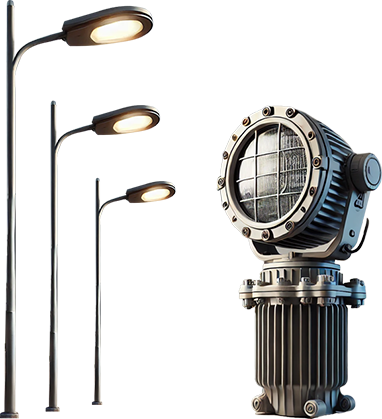
 Traditional automobile die castings
Traditional automobile die castings New energy automobile die castings
New energy automobile die castings Communication housing die castings
Communication housing die castings Electric scooter die castings
Electric scooter die castings Bicycle power motor die castings
Bicycle power motor die castings Motorcycle accessories die castings
Motorcycle accessories die castings Motor housing die castings
Motor housing die castings Engineering machinery die castings
Engineering machinery die castings Lighting die castings
Lighting die castings Outboard motor die castings
Outboard motor die castings Furniture accessories die castings
Furniture accessories die castings Grill accessories die casting
Grill accessories die casting Photovoltaic inverter die castings
Photovoltaic inverter die castings